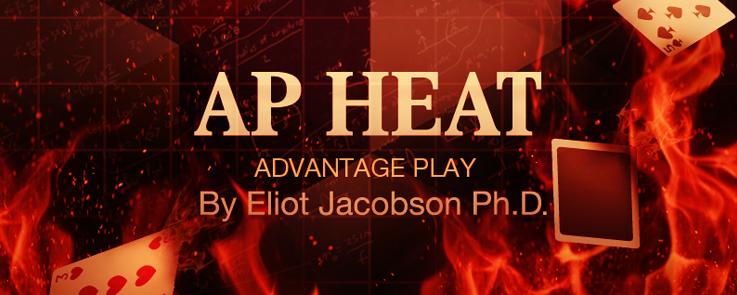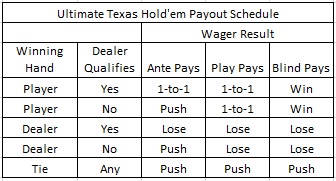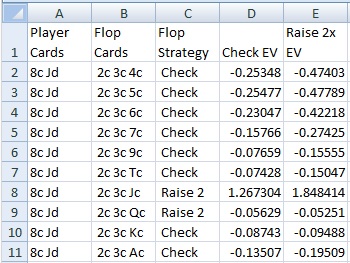Ultimate Texas Hold'em Basic Strategy and House Edge

Ultimate Texas Hold'em (UTH) is one of the most popular novelty games in the market. For that reason, it is important to understand the multitude of ways that UTH may be vulnerable to advantage play. Many of my recent posts have concerned some of these possibilities. But the computations are tedious. It took my computer 5 days to run the cycle where the AP sees one dealer hole-card (see this post). Then my computer spent 8 days analyzing the situation where the AP sees one dealer hole-card and one Flop card (see this post). After that, my computer crunched hands for just over 2 days considering computer-perfect collusion with six players at the table (see this post). After all of this time spent on more advanced plays, I decided to take a step back to compute the house edge off the top, using perfect basic strategy and no advantage play. It took my computer three days to run the pre-Flop cycle and another two days to run the Flop cycle. Finally, I have some basic strategy data to present.
This analysis has been done before and has been done better by both Michael Shackleford and James Grosjean. In particular, Michael Shackleford's extraordinary page on UTH includes a practical strategy for the Flop (check / raise 2x) and Turn/River (raise 1x / fold) bets, which I will borrow here in my presentation. In light of what has been done before, if I had nothing new to offer here, I would forgo this post. However, as the reader will soon see, this work includes megabytes of new fun.
As a reminder, here are the rules for UTH (taken from this document):
-
The player makes equal bets on the Ante and Blind.
-
Five community cards are dealt face down in the middle of the table.
-
The dealer gives each player and herself a set of two starting cards, face down.
-
Players now have a choice:
-
Check (do nothing); or
-
Make a Play bet of 3x or 4x their Ante.
-
-
The dealer then reveals the first three community cards (the "Flop" cards).
-
Players who have not yet made a Play bet have a choice:
-
Check: or
-
Make a Play bet of 2x their Ante.
-
-
The dealer then reveals the final two community cards (the "Turn/River" cards).
-
Player who have not yet made a Play bet have a choice:
-
Fold and forfeit their Ante and Blind bets; or
-
Make a Play bet of 1x their Ante.
-
-
The dealer the reveals her two starting cards and announces her best five-card hand. The dealer needs a pair or better to "qualify."
Now what? Well, either the dealer qualifies or she doesn't. The player beats, ties or loses to the dealer. Either the player's hand is good enough to qualify for a "Blind" bonus payout, it doesn't. The following table hopefully clarifies all of these possibilities and gives the payouts in every case:

The final piece of the puzzle is the Blind bet. As the payout schedule above shows, if the player wins the hand, regardless if the dealer qualifies, then the player's Blind bet is paid according to the following pay table:
-
Royal Flush pays 500-to-1.
-
Straight Flush pays 50-to-1.
-
Four of a Kind pays 10-to-1.
-
Full House pays 3-to-1.
-
Flush pays 3-to-2.
-
Straight pays 1-to-1.
-
All others push.
Combinatorial Analysis
The following spreadsheet contains my full combinatorial analysis. It presents the 169 unique starting hands, together with the edge for checking and raising 4x. The sheet also gives the number of hands equivalent to the listed hand (the suit-permutations). For example, because the starting hand (2c,7d) is equivalent to (2h, 7s), only the hand (2c,7d) was analyzed.
In particular:
-
The house edge for UTH is 2.18497%.
-
The player checks pre-Flop on 62.29261% of the hands.
-
The player raises 4x pre-Flop on 37.70739% of the hands.
-
The player has a pre-Flop edge over the house on 35.29412% of the hands.
-
The player should never raise 3x pre-Flop.
Pre-Flop Strategy
Here is a summary of pre-Flop basic strategy taken from the spreadsheet above:
-
Raise 4x on the following hands, whether suited or not:
-
A/2 to A/K
-
K/5 to K/Q
-
Q/8 to Q/J
-
J/T
-
-
Raise 4x on the following suited hands:
-
K/2, K/3, K/4
-
Q/6, Q/7
-
J/8, J/9
-
-
Raise on any pair of 3's or higher.
-
Check all other hands.
Flop Strategy
A Flop decision to check or raise 2x is only possible if the player checked pre-Flop. By reference to the pre-Flop strategy above, it turns out there are exactly 100 equivalence classes of starting hands where the player checked pre-Flop. I re-ran my UTH basic strategy program to consider each of these 100 hands and each possible Flop that can appear with that starting hand. For each starting hand where the player checked pre-Flop, there are combin(50,3) = 19,600 Flops to consider. Thus, altogether, I had to evaluate the Flop decision to check or raise 2x for 100 x 19,600 = 1,960,000 situations.
The following four spreadsheets contain the analysis for each of these 1,960,000 possibilities. Each spreadsheet contains the full data for 25 starting hands for the player. Note, these spreadsheets are each approximately 20M in size:
To understand the data in these spreadsheets, the following image gives the first few Flop decisions for the player starting hand (8c, Jd) (see spreadsheet #3):

For example, consider the hand player = (8c, Jd), Flop = (2c, 3c, Jc). Then the EV for checking is 1.267304 and the EV for raising 2x is 1.848414. As is intuitively obvious (because the player paired his Jack), raising 2x is correct here.
Now look at the hand right below that, player = (8c, Jd) and Flop = (2c, 3c, Qc). This is also a hand where the player should raise 2x (the decision is very close), but I have very little intuition for why this might be the case. Perhaps because there is a runner-runner straight draw and a flush draw.
Now look at the very next row. When the player holds (8c, Jd) and the Flop is (2c, 3c, Kc), then it is correct to check. The runner-runner straight no longer exists.
Any attempt to quantify such subtleties into a full strategy must surely be a painstaking task. The reader is invited to cull these four spreadsheets (approx. 80M) and create such a complete strategy for himself: I am going to forgo this exercise.
Michael Shackleford's approximation to Flop strategy is simple and smart. The player should raise 2x with two pair or better, a hidden pair (except pocket 2's) or four to a flush with a kicker of T or higher. We see that the hand given above, where player = (8c, Jd), Flop = (2c, 3c, Qc), violates Shackleford's strategy. It is four to a flush with kicker 8c. Shackleford's incorrect strategy for this hand corresponds to a very small loss of EV (0.377%). This small loss of EV is well worth the investment, given the strategic simplicity it yields.
Turn/River Strategy
One can certainly use Shackleford's very easy Turn/River strategy for the final Turn/River decision: The player should raise 1x when he has a hidden pair, or there are fewer than 21 dealer outs that can beat the player, otherwise he should fold. (see the thread on WizardofVegas.com for a discussion about the meaning of "21 outs.") One can also use Grosjean's more complex strategy from Exhibit CAA, that I won't repeat here. Good luck getting a copy of CAA. (James, make your book available! Please!).
My complete method here, were I to do it, would be to post spreadsheets containing computer-perfect play so that the reader could devise his own Turn/River strategy. By reference to the Flop strategy spreadsheets given above, of the 1,960,000 Flop possibilities, exactly 1,273,842 of them correspond to the player checking on the Flop. Each of these checking possibilities yields an additional combin(47,2) = 1,081 Turn/River hands to complete the board, where the player then has to then choose to either fold or raise 1x on each. That is, the complete spreadsheet analysis of the Turn/River decision would mean posting a total of 1,960,000 x 1,081 = 1,377,023,202 hands for the reader to consider.
Yeah, well ... at any rate, for the curious, here is my derivation of Shackleford's result concerning playing hands with 20 or fewer dealer outs:
Clearly if the player folds, then his EV is -2.
Let N be the number of outs under consideration for the dealer to beat the player. Then the probability that the dealer's first card is an out is p = N/45. For his second card, the dealer who whiffed on his first card most likely has 3 additional "pair outs" to pair his first card and beat the player. He may also generate new straight or flush outs (call these 1 additional "out," so-called "runner-runner"). So, the probability of the dealer beating the player by hitting an out on his second card is approximately (N + 4)/44.
Overall, the probability that the dealer beats the player is then,
p = N/45 + [(45 - N)/45]*[(N + 4)/44].
Simplifying, we get:
p = (-N^2 + 85 N + 180)/(45*44)
Note that if the dealer doesn't hit an out, then he won't qualify. It follows that the EV for the player who raises 1x on the Turn/River bet is:
EV = p*(-3) + (1-p)*(1) = 1 - 4p.
We make the raise whenever EV > -2. That is, 1 - 4p > -2. Solving for p gives
p < 3/4.
That is, the player raises 1x when his chance of beating the dealer is 25% or higher.
Combining the two expressions for p, we see that EV > -2 whenever
(-N^2 + 85 N + 180)/(45*44) < 3/4.
Simplifying gives the quadratic equation,
N^2 - 85N + 1305 > 0
Solving this quadratic equation gives roots:
-
(1/2)*(85 + sqrt(2005)) = 64.9
-
(1/2)*(85 - sqrt(2005)) = 20.1
For the quadratic equation to be positive, N must be either larger than both roots or smaller than both roots. That is, either N ≥ 65 or N ≤ 20. The first case is the "impossible solution," leading to the conclusion that there can be at most 20 dealer outs that can beat the player.
Conclusion
Here is a summary of the edges for the strategies referenced above:
-
Computer-perfect strategy for UTH yields a house edge of 2.18497%.
-
Shackleford's practical strategy for UTH yields a house edge of about 2.43%.
-
Grosjean's strategy for UTH in Exhibit CAA yields a house edge of 2.35%.


